The Samsung Galaxy S21 Ultra & S21 Review: The Near Perfect and The Different
by Andrei Frumusanu on February 22, 2021 12:00 PM EST- Posted in
- Smartphones
- Samsung
- Mobile
- Galaxy S21
- Galaxy S21 Ultra
Display Measurement
We’ve noted many times now that the displays of the S21 series are relatively special, although for different reasons depending on the model.
The S21 Ultra’s new panel uses a new hybrid oxide pack panel technology along with a new OLED emitter generation that allows it offer seamless fine-grained refresh rate switching along with getting extremely bright while being much more power efficient. The smaller S21 doesn’t have any of the new display technologies, it is lower resolution, but still has software based adaptive frequency features. I did note that at least in terms of hardware build quality, the smaller S21 does seem to have advantages over the S20 series when it comes to its lamination, as I am seeing better viewing angles, and the panel being better glued to the glass.
When it comes to colour accuracy, we find Samsung’s usual display modes, limited to a “Vivid” setting that’s more saturated in terms of the colours, and allows you to fine-tune colour temperature to your taste, and the “Natural” screen mode that tries to adhere to sRGB and Display P3 colour gamuts and features near 6500K whites.
We move on to the display calibration and fundamental display measurements of the Galaxy S21 Ultra and S21 screens. As always, we thank X-Rite and SpecraCal, as our measurements are performed with an X-Rite i1Pro 2 spectrophotometer, with the exception of black levels which are measured with an i1Display Pro colorimeter. Data is collected and examined using Portrait Display's CalMAN software.

When it comes to screen brightness, the Galaxy S21 isn’t all much different to the S20 series, although it does allow for brighter manual brightness up to 393 nits on our unit. Peak full screen whites are still at around 700 nits when in auto-brightness mode under bright ambient conditions.
The S21 Ultra’s brightness is beyond any other OLED display on the market right now. Manual brightness is still limited by Samsung to only 462 nits, however when in auto-brightness, it goes to a staggering 942 nits – almost beating the superbly bright RGBW LCD display of the LG G7.
If you’re looking for a device which does excellently under sunlight, then the S21 Ultra is definitely the right choice.
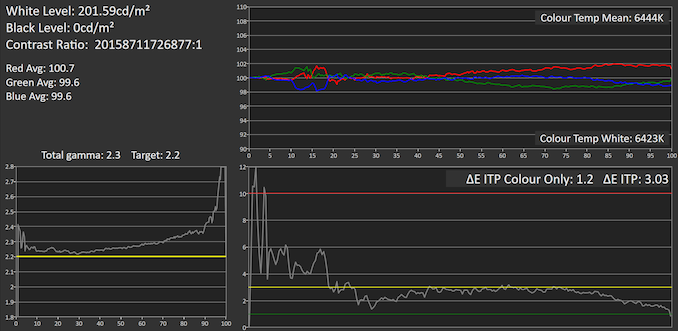
 Portrait Displays CalMAN
Portrait Displays CalMAN
Galaxy S21 Ultra
In terms of greyscale accuracy, the good news for this generation is that it seems Samsung has done a better job than in past years. Whites fall in at 6423K on the S21 Ultra, much less red than the S20 series devices’ calibration, with general great colour balance at dEITP of only 1.2. Gamma curve also looks reasonable although it’s still hard to measure this accurately due to Samsung’s APL brightness adjustments, even with fixed 50 APL and 50% windows sizes during out measurements.
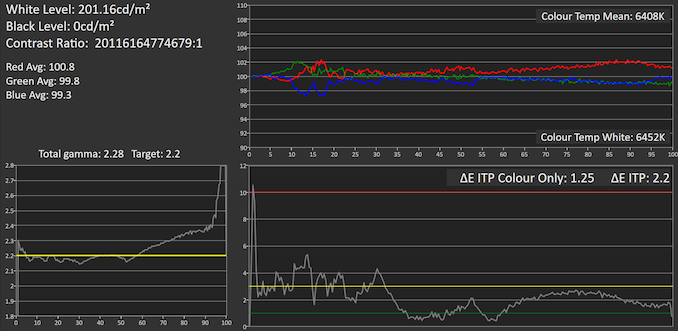
 Portrait Displays CalMAN
Portrait Displays CalMAN
Galaxy S21
The smaller Galaxy S21 also does very well, with great colour temperature out of the box .
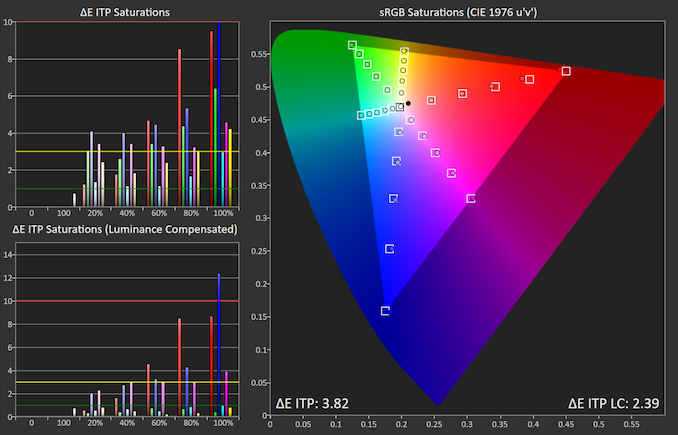 Portrait Displays CalMAN
Portrait Displays CalMAN
Galaxy S21 Ultra
Saturation accuracy on the S21 Ultra is great in all aspects except the reds, which for some reason are undersaturated at the maximum intensities.
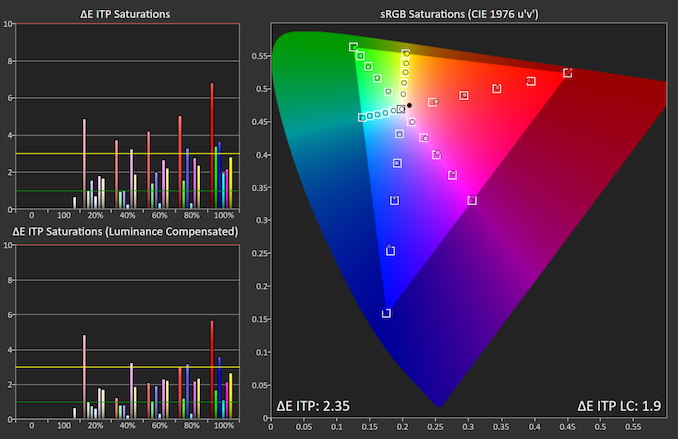 Portrait Displays CalMAN
Portrait Displays CalMAN
Galaxy S21
The smaller S21 doesn’t have the same issue, showcasing generally more accurate colours.

 Portrait Displays CalMAN
Portrait Displays CalMAN
Galaxy S21 Ultra
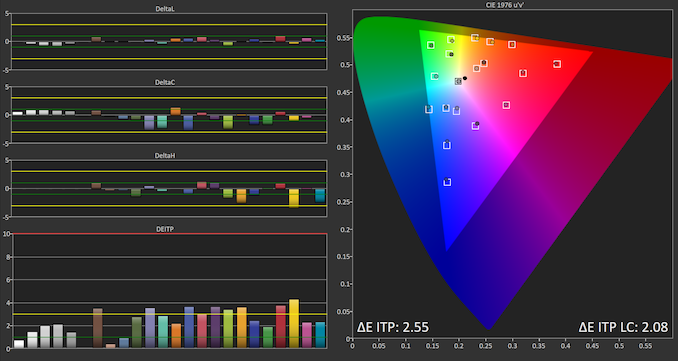
 Portrait Displays CalMAN
Portrait Displays CalMAN
Galaxy S21
Gretag MacBeth test patches with common colours such as skin tones fare well for both the S21 Ultra as well as the S21, although the latter does better, showcasing less luminosity errors.
Overall, Samsung did uncharacteristically well this year when it comes to colour accuracy. After a few years of glaring gamma issues and too warm whites, the S21 series seems to be able to achieve great results out of the box, early on in its firmware, which couldn’t be said of the S10 or S20 series.
The S21 Ultra’s display in terms of its fundamentals is outstanding – it gets extremely bright, more than any other phone in the market right now. Together with the 1440p resolution and 120Hz refresh rate, it represents the single best mobile display in the industry right now.
The smaller S21 display is good, although really not in the same class as the Ultra’s panel. There’s really nothing much to write home about here, as it’s very much similar to many other 1080p panels in the industry, with good brightness levels, good colour accuracy, and of course also featuring that 120Hz adaptive refresh rate mode. If the Ultra’s panel is an S-tier display, the baseline model’s display is A-tier.


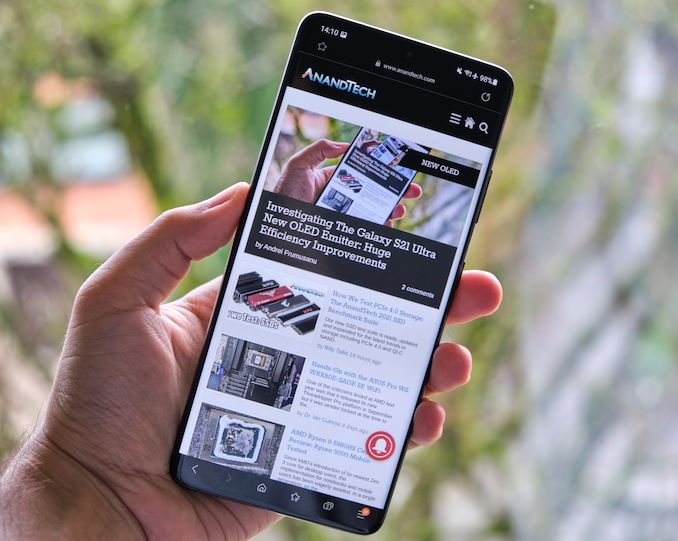








122 Comments
View All Comments
theblitz707 - Wednesday, March 3, 2021 - link
I dont get when people say android lag. My s10+ never lag in daily usageprobedb - Tuesday, February 23, 2021 - link
Have the S21, previously the S20+. Far prefer the S21, flat screen...it's in a case so makes no difference. Screen res, well since the S20+ required you to go FHD to use 120Hz then it makes very little difference and I use it a lot every day. Fingerprint reader is waaaaaaaaay better, like orders of magnitude better. The S20+ was awful for the delay in recognising your print, much faster on the S21. The S21 just feels faster overall as well. Perfectly happy especially since Samsung did a very good trade-in on the S20+, plus selling the free tag and phones meant it cost very little overall.eastcoast_pete - Tuesday, February 23, 2021 - link
Thanks Andrei for the review. Just one fly in the "currently on sale in the US" for the S21 Ultra: yes, that's correct, but only the 128 GB storage version is on sale, the others are "out of stock". And, absent an option for expandable storage, I wouldn't buy a premium phone with less than 256 GB. Videos and photos eat storage.Andrei Frumusanu - Tuesday, February 23, 2021 - link
True for the 256GB, but the 512GB is also in stock at $1,179.99 which is less than the 128GB MSRP.pse - Tuesday, February 23, 2021 - link
Excellent review, as usual, Andrei. I was hoping to see a few video samples as well. I've found, by looking at other online samples, that there are significant differences in low light video processing between the SD888 and the Exynos 2100, I was wondering if you found similar results in your tests. Cheers!Andrei Frumusanu - Tuesday, February 23, 2021 - link
Frankly speaking any results right now are outdated as Samsung is pushing out firmware updates at a fast pace with the cameras behaving differently.We'll revisit everything in a few weeks/months.
The hard truth - Tuesday, February 23, 2021 - link
There's no talk about the video aspect of the camera in this review. Therefore this review is incomplete and poor.JoeDuarte - Tuesday, February 23, 2021 - link
Note that the actual price can be well below half of MSRP if you buy directly from Samsung and trade in an older phone.I'm paying $285 instead of $849 for the S21 256 GB model. I'm trading in a Galaxy S10E. I feel like the S21 is a steal for $285.
Also, Samsung is on Rakuten with 10% off, so I'm getting $28.50 back. So now we're down to $256.50.
I'm getting a "$100 Samsung credit" as well, but I haven't looked into that. I guess it's for the Samsung store? Maybe I can get some earbuds or something.
I posted a screenshot of the deal/order here: https://imgur.com/a/7iPWqw6
I'm not clear on their statement math, but the bottom line is that I got the phone for just over $250. (I think they assessed sales tax on the full list price of the phone though – I'm not sure if that's normal or locale-specific.)
ottonis - Tuesday, February 23, 2021 - link
First of all, many thanks for this huge test/review! Really very informative and useful information.However, is there test planned on the video capabilities of these phones?
flyingpants265 - Tuesday, February 23, 2021 - link
no headphone jack = no buy, it's an open and obvious conspiracy to make billions in revenue from crappy wireless headphones.no front speakers = no buy, I don't care if most people don't notice the difference, how the hell can you purposefully make subpar products for ~14 years straight? Front stereo speakers are obviously superior, you can listen to youtube in landscape mode or use a small kickstand, you can use the phone with a gamepad, and get full sound without having to mess with bluetooth, headphones, or the crappy sidefiring speaker which isn't even close, stop making excuses.
Also, all phones should be 100% rated for underwater use. Obviously the battery should be replaceable when it starts to degrade. Again, it doesn't benefit a manufacturer to make an indestructible phone. But it would be a great idea for any company with low market share.
Android royally sucks. We're ~14 years in or something now, SoCs have increased in power and have 12GB RAM, but they still can't do the very basics of what I could do with Windows 98SE or 2000, namely, have multiple windows open/loaded into RAM and switch between them instantly. Press alt-tab on your computer a few times and tell me how long that takes. Compare that to phone "app switching" and phone "keyboard lag". The OS and apps are poorly written, there is no excuse for that. Removing features, garbage obfuscated slow UI. Crap.
Of course this is just the beginning. Every single day, humanity just makes excuses for mediocrity and ends up getting screwed by billion-dollar companies. At least if I'm going to have a $1000 brainwashing/tracking device, I want it to be designed properly. And yes, I could do better on all accounts. There's a giant hole in the market for an... ACTUAL GOOD PHONE.